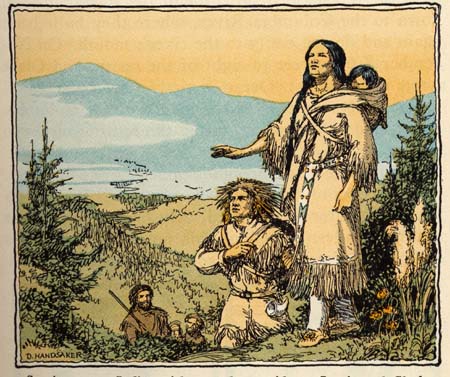Almost all Northwesterners have heard of Sacagawea. Not being an Oregon native myself, I imagine elementary school children in the Northwest spending a great deal of time studying the Lewis and Clark Expedition and all the members of the Corps who helped make the journey successful, especially minorities like Sacagawea and York.
But what do we really know about the amazing Native woman who guided the Corps of Discovery across the West? There are several disputed facts in Sacagawea’s story, but perhaps one of the most thrilling controversies surrounding this inspiring woman is not an argument over her life accomplishments, but rather a disagreement over when and how she died. Now, on the supposed 127 anniversary of her death, it is time to revisit this controversy.

Sacagawea helped to lead the Lewis and Clark Expedition across the West
Up until the publishing of Grace Raymond Hebard’s book Sacajawea in 1933, the commonly accepted date of Sacagawea’s death was December 20, 1812. The book, and several facts therein, sparked the great debate regarding the Shoshone Native’s demise.
What we know for sure is that an 1811 journal entry of Henry Breckenridge, a fur dealer at Fort Manuel, indicated that Sacagawea was living at the fort in Missouri with her husband Touissant Charbonneau, a member of the Corps and a French-Canadian explorer and trader.
We also know that on December 20, 1812, another trapper, John Luttig, recorded a journal entry that states, “This evening the Wife of Charbonneau a Snake Squaw, died of a putrid fever she was good and the best woman in the fort, aged about 25 years. She left a fine infant girl.”
William Clark’s records also indicate that Sacagawea’s life ended early on. In a list of Expedition members compiled between 1825 and 1828 Clark writes: “Se-car-ja-we-au Dead.”
According to the Orphan’s Court Records of St. Louis, Missouri, Clark also adopted Sacagawea’s two children in August of 1813, Jean Baptiste Charbonneau and Lizette Charbonneau. At that time, in order to allow adoption, both parents of a child had to be confirmed dead in court.
Charbonneau supposedly died when Natives attacked Fort Manuel in 1813, killing 15 men.
Case closed? Not entirely. Charbonneau was a known polygamist, taking several “squaw” wives. This is where the dispute begins.
Hebard and several others propose that since Luttig doesn’t name Charbonneau’s wife in the journal entry, we cannot be sure if that wife was, in fact, Sacagawea.
Hebard suggests that Sacagawea returned to live with the Shoshone people in Wyoming, and lived a long, happy life, dying in April of 1884, which would mean that this month would mark the 127 anniversary of her death.

Grace Hebard was an author and Wyoming historian whose work helped lead to the Sacagawea controversy
A Shoshone oral history corroborates this fact, and a burial plot marker on the Shoshone Wind River Reservation in Wyoming suggests the date of death above.
Next, minister Rev. John Roberts recalled in 1907 that he buried a Native woman on the Wind River Reservation. Apparently, he had been told that this woman was Sacagawea.
To spite this burial marker and oral history evidence, it is often suggested that Hebard, a Wyoming historian and author, romanticized the history of the state, and embellished the truth. Unfortunately for Hebard, Rev. John Roberts was quoted in 1945 indicating his doubt that the woman he buried was Sacagawea.
“All I know is I buried an old Indian woman,” he said. “The historian [Grace Raymond Hebard] told me she was Sacajawea.”
Another factor that might discredit Hebard is that the Shoshone tribe never lived in Wyoming during Sacagawea’s life, but actually inhabited Montana and Idaho. However, the reservations established for the Shoshone tribe after the Indian Removal Act were located in parts of Wyoming, and the Shoshone oral tradition suggests that Sacagawea lived a long life, after returning to live with her people.
It is difficult to discredit Hebard’s theory fully, both because of the oral history evidence that backs up Sacagawea’s death in 1884, and because not much is written about the Native woman’s life after the Corps of Discovery.
Little is known about her life after the Expedition took place, especially since her ethnic identity and gender made her life of little consequence to white or Native society in the early 1800s.
I guess we will never know when Sacagawea actually died, but I like to believe that Hebard’s story is true. It is, at least, a rosier picture of the Native woman’s life, especially after such a rough beginning.
Sacagawea was purportedly kidnapped and forced to marry Charbonneau at a very young age, and when he was hired on with the Corps of Discovery in the early 1800s, she was expected to help the Corps navigate the West, while pregnant with Charbonneau’s son.
The idea that this strong Native woman lived a fulfilled life with her people, however romanticized this idea might be, rather than dying from fever at 25, is the controversial story I choose to accept.

